The post ScaleOut Discusses Contact Tracing in The Record appeared first on ScaleOut Software.
]]>Also read our Partner Perspective in the same issue, which explains how the Microsoft Azure cloud provides a powerful platform for hosting the ScaleOut Digital Twin Streaming Service and ensures high performance across a wide range of applications.
and ensures high performance across a wide range of applications.
The post ScaleOut Discusses Contact Tracing in The Record appeared first on ScaleOut Software.
]]>The post Founder & CEO William Bain Discusses Real-Time Digital Twins with TechStrong TV appeared first on ScaleOut Software.
]]>Watch the video here.
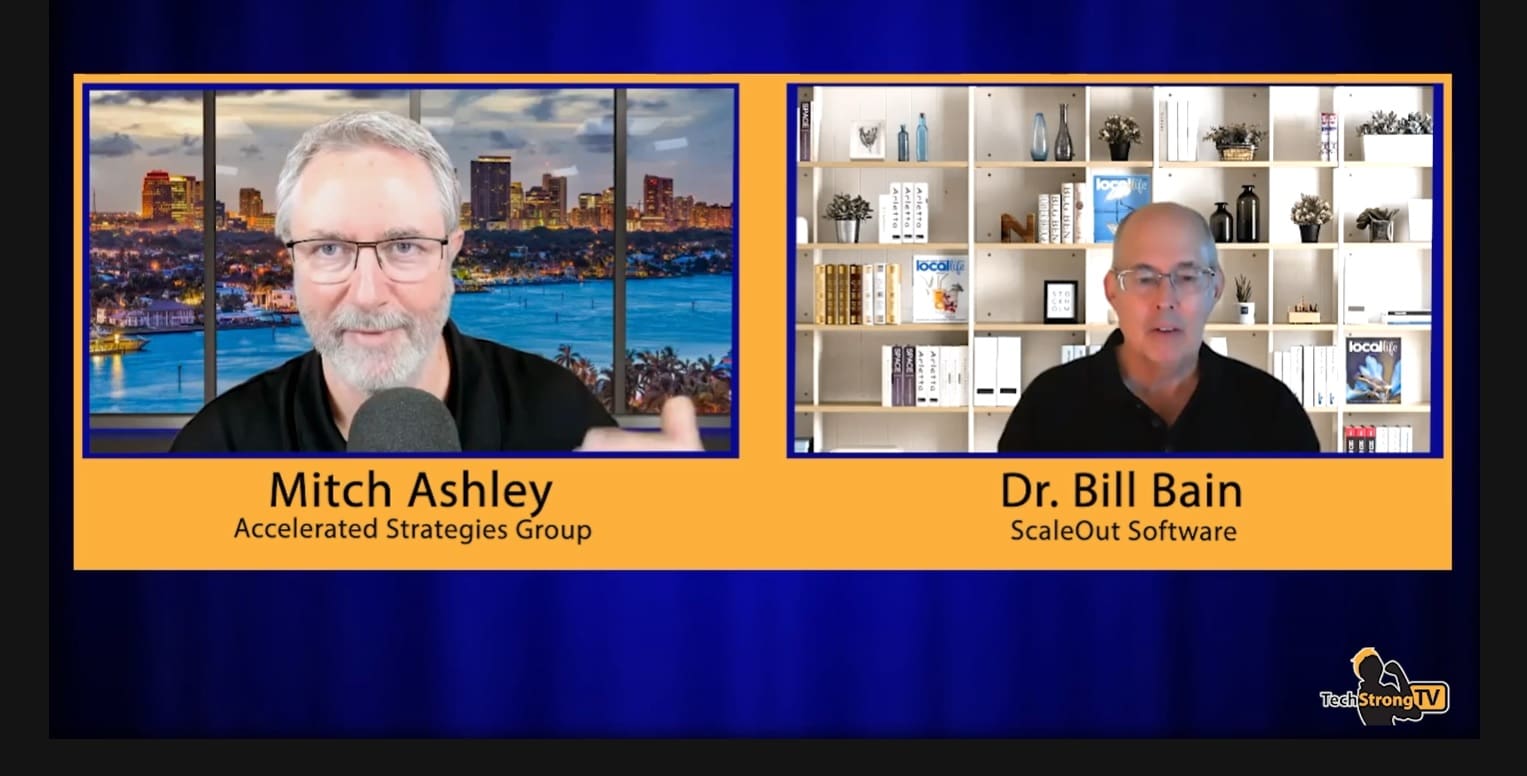
The post Founder & CEO William Bain Discusses Real-Time Digital Twins with TechStrong TV appeared first on ScaleOut Software.
]]>The post Using Real-Time Digital Twins for Corporate Contact Tracing appeared first on ScaleOut Software.
]]>
Until a COVID-19 vaccine is widely available, getting back to work means keeping a close watch for outbreaks and quickly containing them when they occur. While the prospects for accomplishing this within large companies seem daunting, tracking contacts between employees may be much easier than for the public at large. This blog post explains how a software application built with a new software construct called real-time digital twins makes this possible.
Tracking Employees Using Real-Time Digital Twins
In an earlier blog post, we saw how real-time digital twins running in the ScaleOut Digital Twin Streaming Service can be used to track employees within a large company using a technique called “voluntary self-tracing.” In this post, we’ll take a closer look at its implementation in a demo application created by ScaleOut Software. We’ll also look at a companion mobile app that allows employees to log contacts with colleagues outside their immediate teams and to notify the company and their contacts if they test positive for COVID-19.
can be used to track employees within a large company using a technique called “voluntary self-tracing.” In this post, we’ll take a closer look at its implementation in a demo application created by ScaleOut Software. We’ll also look at a companion mobile app that allows employees to log contacts with colleagues outside their immediate teams and to notify the company and their contacts if they test positive for COVID-19.
The demo application creates a memory-based real-time digital twin for each employee. Using information from the company’s organizational database, it populates each twin with the employee’s ID, team ID, department type, and location. The twin also keeps a list of the employee’s contacts within the organization (as well as community contacts, discussed below). This allows immediate colleagues and their contacts to be notified if an employee tests positive. The following diagram illustrates an employee’s real-time digital twin and the state data it holds; details about the contact tracing code are explained below:

The twin automatically populates its contact list with the other members of the employee’s team, based on the expectation that team members are in daily contact. Using the mobile app, employees can log one-time and recurring contacts with colleagues in other teams, possibly at different office locations. In addition, they can log contacts outside the company, such as taxi rides, airline flights, and meals at restaurants, so that community members can be notified if an employee was exposed to COVID-19.
An employee can use the mobile app to notify their real-time digital twin of a positive test for COVID-19. Code running in the twin then sends messages to the real-time digital twins for all contacts in the employee’s list. These twins in turn send messages to their contacts, and so on, until the twins for all contacts have been notified. (The algorithm avoids unnecessary messages to team members and circular paths among twins.) The twin then sends a push notification to each affected employee through the mobile app, alerting them to the possible exposure and the number of intermediate contacts between themselves and the infected person. Because real-time digital twins are hosted in memory, all of this happens within seconds, enabling affected employees to immediately self-quarantine and obtain COVID-19 tests.
Here’s an illustration of the chain of contacts originating with an employee who reports testing positive. (Note that the outbound notifications from the twins to the employees’ mobile devices are not shown here.)

What’s in the Real-Time Digital Twin?
As illustrated in the first diagram, each real-time digital twin hosts two components, state data and a message-processing method. These are defined by the contact tracing application and can be written in C#, Java, or JavaScript. (C# was used for the demo application.) The state data is unique for each employee and contains the employee’s information and contact list, along with useful statistics, such as how often the employee has been alerted about a possible exposure. The message-processing method’s code is shared by all twins. It receives messages from the mobile app or from other twins (each corresponding to a single employee) and uses application-defined code to process these messages.
Messages from the mobile app can request to add or remove a contact from the list. For new contacts, they include parameters such as the employee ID of the contact and whether the contact will be recurring. (Users also can record contacts using calendar events.) Messages from the mobile app can also request the current contact list for display, signal that the employee has tested positive or negative, and request current notifications. Messages from other real-time digital twins signal that the corresponding employees have been exposed and provide additional information, such as the number of intermediate contacts and the location of the initial employee who tested positive.
The application’s message-processing code responds to these messages and implements the spanning-tree notification algorithm that alerts other twins on the contact list. The streaming service handles the rest, namely the details of message delivery, retrieval and updating of state information, and managing the execution platform.
Using the Mobile App
The following animated diagram shows how an employee can add a contact with a company colleague outside of their immediate team or with a community contact during business travel (left screenshot). If the employee tests positive, the employee can use the mobile app to report this to the company (middle screenshot). All employees are then notified using the mobile app, as shown in the right screenshot. Community contacts are reported to managers who communicate with outside points of contact, such as airlines, taxi companies, and restaurants.
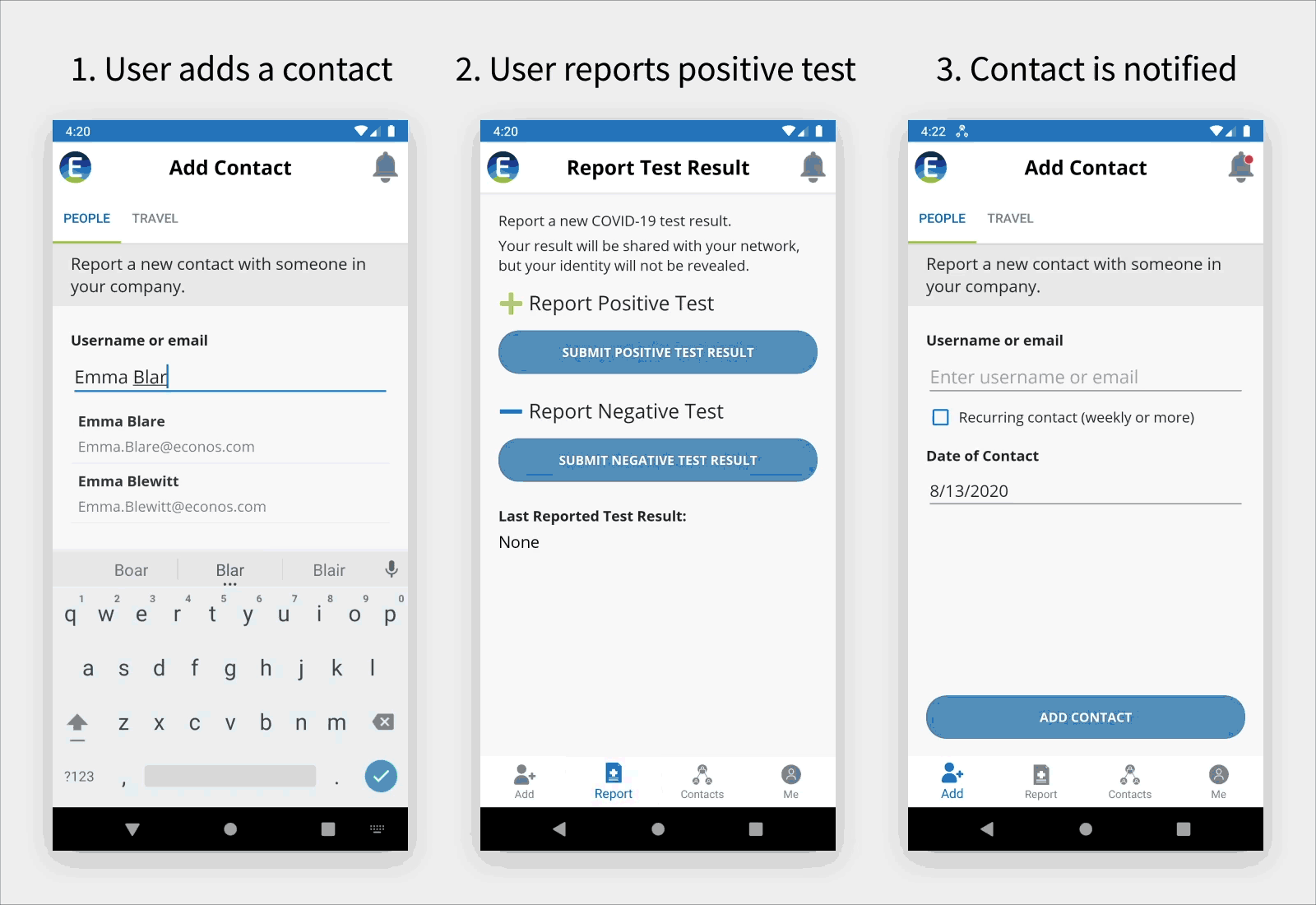
Using Aggregate Statistics to Spot Outbreaks
The streaming service has the built-in capability to aggregate state data from all real-time digital twins. The service then displays the results in charts which are recalculated every few seconds. These charts enable managers to identify emerging issues, such as an outbreak within a specific department or site. With this information, they can take immediate steps to contain the outbreak and minimize the number of affected employees.
To illustrate the value of aggregate statistics in boosting situational awareness, consider a hypothetical company with 30,000 employees and offices in several states across the U.S. Suppose an employee at the Texas site suddenly tests positive. This could be immediately alerted to managers with the following chart generated and continuously updated by the streaming service, which shows all employees who have tested positive:

Within a few seconds, the real-time digital twins notify all points of contact. Updates to state data are immediately aggregated in another chart that shows the sites where employees have been notified of a positive contact and the number of employees affected at each site:

This chart shows that about 140 employees in three states were notified and possibly exposed directly or indirectly. All of these employees are then immediately quarantined to contain the possible spread of COVID-19. After an investigation by company managers, it is determined that the employee had business travel to Arizona and met with a team that subsequently had business travel to California. Instead of taking hours or days to uncover the scope of a COVID-19 exposure, contact tracing using real-time digital twins alerts managers within seconds.
The real-time digital twins can collect additional useful statistics for visualization by the streaming service. Another chart can show the average number of intermediate contacts for all notified employees, which is an indication of how widely employees have been interacting across teams. If this becomes an issue (as it is in the above example), managers can implement policies to further isolate teams. As shown below, a chart can also show the number of notified employees by department so that managers can determine whether certain departments, such as retail outlets, need stricter policies to limit exposure to COVID-19 from outside contacts.

The Benefits of an Integrated Streaming Service
This contact tracing application demonstrates the power of real-time digital twins to enable fast application development with compelling benefits. Because the amount of application code is small, real-time digital twins can be quickly written and tested. (See a recent blog post which describes how to simplify debugging and testing using a mock environment prior to deployment in the cloud.) They also can be easily modified and updated.
The ScaleOut Digital Twin Streaming Service provides the execution platform so that the application code does not have to deal with message distribution, state saving, performance scaling, and high availability. It also includes support for real-time aggregate analytics and visualization integrated with the real-time digital twin model to maximize ease of use.
Compare this approach to the complexity of building out an application server farm, database, analytics application, and visualization to accomplish the same goals at higher cost and lower performance. Cobbling together these diverse technologies would require several skill sets, lengthy development time, and higher operational costs.
Summing Up
This demo contact tracing application was designed to show how companies can take advantage of their organizational structures to track contacts among employees and quickly notify all affected employees when an individual tests positive for COVID-19. By responding quickly to an exposure with immediate, comprehensive information about its extent within the company (and with community contacts), managers can limit the exposure’s impact. The application also shows how the real-time digital twin model enables a quick, agile implementation which can be easily adapted to the specific needs of a wide range of companies.
Please contact us at ScaleOut Software to learn more about this demo application for limiting the impact of COVID-19 and other ways real-time digital twins can help your company monitor and respond to fast-changing events.
The post Using Real-Time Digital Twins for Corporate Contact Tracing appeared first on ScaleOut Software.
]]>The post Voluntary Contact Self-Tracing for Companies appeared first on ScaleOut Software.
]]>
How Voluntary Self-Tracing Helps
In a previous blog post, we explored how voluntary contact self-tracing can assist other contact tracing techniques in alerting people who may have been exposed to the COVID-19 virus. This technique enables participants to log interactions with others so that they can discover if they are in a chain of contacts originating with someone, often a stranger, who subsequently tests positive for the virus. These contacts could include friends at a barbeque, grocery checkers, hairdressers, restaurant waitstaff, taxi drivers, or other interactions.
In contrast to highly publicized, proximity-based contact tracing by using mobile devices, voluntary self-tracing avoids security and privacy issues that have threatened widespread adoption. It also adds human judgment to the process so that the chain of contacts captures only potentially risky interactions. This is accomplished in advance of a positive test, enabling immediate notifications when the need arises.
Voluntary self-tracing offers huge value in connecting strangers who otherwise would not be notified about the need for testing without arduous manual contact tracing. However, it imposes the burden that everyone participates in a common tracing system and consistently makes the effort to log interactions. While this might restrict its appeal for public use, it could be readily adopted by companies, which have well-known, slowly changing populations and established working relationships and protocols.
Helping Companies Get Back to Work
Consider a company that has multiple departments distributed across several locations. As employees come back to work, they typically interact closely with colleagues in the same department. If anyone in the department tests positive for COVID-19, it’s likely that all of these colleagues have been exposed and need to get tested. In addition, employees occasionally interact with colleagues in other departments, both at the same site and at remote sites. These interactions also need to be tracked to contain exposure within the organization, as illustrated in the following diagram:

Voluntary contact self-tracing can handle the most common scenarios by using the company’s employee database to automatically connect colleagues who work in the same department and interact daily. Employees need only manually log contacts they make with employees in other departments. These interactions are relatively infrequent and tracked for a limited period of time (typically two weeks). This approach streamlines the work required to track contacts, while enabling the company to immediately identify all employees who need to be notified, tested, and possibly isolated after one person tests positive.
In addition, employees can manually track information about contacts they make while on business travel, such as during airline flights, taxi rides, and meals at restaurants. That way, when an employee tests positive, these external contacts can be immediately alerted of possible exposure. This enables companies to assist their communities in contact tracing and help contain the spread of COVID-19.
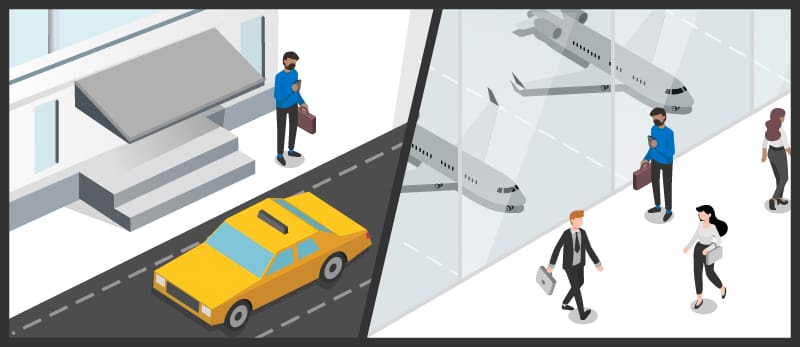
Enabling Technology: In-Memory Computing
Many large companies have tens of thousands of employees and need to perform fast, efficient contact tracing. They require both immediate notifications and up-to-the-moment statistics that identify emerging trends, such as hot spots at one of their offices. To make this possible, a technology called in-memory computing can be used to track contacts and immediately alert all affected employees (and community touchpoints, such as restaurants) when anyone tests positive and alerts the system. Using a mobile app connected to a cloud service, it creates and maintains a dynamic web of contacts that evolves as interactions occur and time passes.
For example, when an employee tests positive and alerts the system, all colleagues in the same department are quickly notified, as are employees in other departments with whom interactions have occurred. The contact tracing system follows the chain of contacts across departments at all locations within the company. It also notifies community contacts, such as airlines and taxi companies, of possible exposures so that they can take the appropriate action.
Within the cloud service, the in-memory computing system maintains a software-based real-time digital twin for each employee. This software twin records and maintains all contacts for the employee, as well as all community contacts. It also removes non-recurring contacts after sufficient time passes and exposure is no longer likely. When an employee tests positive, the mobile app notifies the corresponding real-time digital twin in the cloud. This sets off the chain of communication that alerts all connected twins to the exposure and notifies their real-world counterparts.
Maximizing Situational Awareness
Real-time digital twins contain a wealth of dynamic, up-to-the-minute information that can be tapped to help managers maintain situational awareness about rapidly evolving exposures and ongoing progress to contain them. In-memory computing technology can aggregate this data and visually present the results to help immediately spot outbreaks and identify significant problem areas. For example, the following chart, which can be updated every few seconds, shows the number of employees who have just tested positive at each site within a company:
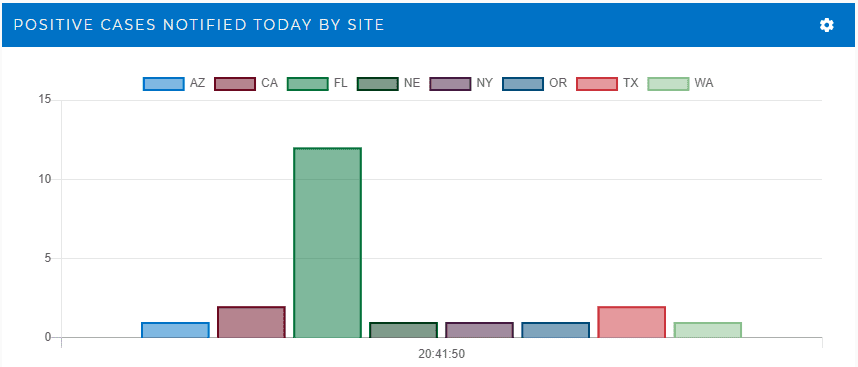
The chart shows a jump in cases for employees at the Florida site. Managers can then investigate the source of the outbreak by department at this site:

Not surprisingly, most cases are occurring in the Retail department, most likely because of its large number of interactions with customers, and this department needs to take additional steps to limit exposure. With real-time aggregate analytics, managers can also track other important indicators, such as the number of employees and sites affected by an outbreak, the average number of interconnected contacts, and the percentage of affected employees who have received notifications and taken action.
Getting Back to Work Safely
As companies strive to restore to a normal working environment, managers recognize the need to carefully track the occurrence of COVID-19 in the workplace and minimize its propagation throughout an organization. Immediately notifying and isolating all affected employees helps to limit the size of an outbreak, while analyzing the sources and evolution of incidents assists managers in the moment and as they develop new policies and strategies. With its ability to track and analyze fast-changing data in real time, in-memory computing technology offers a powerful and flexible toolset for contact tracing, helping employees get back to work safely.
The post Voluntary Contact Self-Tracing for Companies appeared first on ScaleOut Software.
]]>The post Voluntary & Anonymous Contact “Self”-Tracing at Scale appeared first on ScaleOut Software.
]]>A New Approach: Log Our Own Contacts in Advance
As we all know, getting people back to work will require testing and contact tracing. The latter will need armies of people to track down all contacts of each person who tests positive for coronavirus. Leading software companies are building mobile apps to log the places we have been and determine possible contacts. However, these apps will be complex by relying on Bluetooth wireless technology to detect proximity, and they raise concerns regarding both accuracy and privacy. Experts have stated that humans need to be in the loop for contact tracing to be effective. Maybe there’s a hybrid approach that offers promise in the near term.
What if we could easily and anonymously let people keep track of encounters as they occur that they judge to be potentially risky, such as with work colleagues, merchants, neighbors, and friends? As people log these contacts using aliases for privacy, cloud software could build a web of connections, often connecting strangers through intermediaries. Later, when a person tests positive, he or she could notify this software. It then could follow the breadcrumbs and anonymously alert via text message or email all people who recently came into contact and should be tested and/or self-isolated.
Here’s an example. When a grocery checker with the alias “flash88” tests positive for COVID-19, he can anonymously alert a chain of people who are connected by direct or intermediate contacts who have logged significant, recent encounters, such as haircuts or backyard barbeques:

Although voluntarily “self-tracing” our contacts would require proactive effort for each of us to log individual encounters, it could be done quickly and simply by just entering a person’s anonymous alias into a mobile app or web page. Most people likely would choose to do this only for lengthy interactions, such as with colleagues working closely together, friends at a barbeque, or perhaps a hairdresser or server at a restaurant. Location information could be included if permitted. What emerges from countless individual actions is a massive, continuously evolving web of contacts that can be immediately called upon for alerting when anyone tests positive.
For self-tracing to be effective, people who come into mutual contact need to register aliases and contact information (email or mobile number) with the software. As each person encounters a potentially risky contact and logs that contact’s alias, the system builds a record of the contact just for the period of time that risk of infection is possible, possibly two weeks. Regular work contacts could automatically be refreshed on a schedule.
The power of self-tracing is its ability to give us automatic, immediate — and anonymous — notification of exposure risk from a chain of contacts. While this tool does not replace standard contact tracing, it can add important value in its simplicity, timeliness, and incorporation of human judgment. As an alternative to more complicated and invasive Bluetooth-based contact tracing software, it could help accelerate the return to work for colleagues and businesses while offloading some of the work for contact tracers.
Advanced Capabilities
Beyond just tracking contacts, cloud-hosted software can keep track of important statistics, such as when and where (if permitted) a person tested positive or was alerted and how many in a chain separate a person from the source of an alert. Real-time analytics can continuously evaluate this data to immediately identify important trends, such as the locations where an unusually large number of alerts are occurring. This allows personnel to quickly respond and institute a self-isolation protocol where necessary.
Real-time analytics also can generate other useful statistics, such as the average chain length that results in co-infection and the percentage of connected people who actually become co-infected. If anonymous demographics are maintained and submitted by users, statistics can be computed by gender, age, and other parameters useful to healthcare professionals.
The Tech: In-Memory Cloud Computing Makes Self-Tracing Fast and Scalable
Cloud-hosted software technology called in-memory computing makes this contact tracing technique fast, scalable and quickly deployable. (It also can be used to assist other contact tracing efforts and for asset tracking.) While simultaneously tracking contacts for millions of people, this software can alert all related contacts in a matter of seconds after notification, and it can send out many thousands of alerts every second.
When a person tests positive and notifies the software, a cloud-based system uses the record of contacts kept with each person to send out alerts, and it follows these records from contact to contact until all mutually connected people have been alerted. In addition, human contact tracers could take advantage of this network (if permitted by users) to aid in their investigations.
ScaleOut Software has developed an in-memory, cloud-hosted software technology called real-time digital twins which make hosting this application easy, fast, and flexible. As illustrated below, cloud software can maintain a real-time digital twin for each user being tracked in the system to keep dynamic data for both alerting and real-time analytics. In addition to processing alerts, this software continuously extracts dynamic data from the real-time digital twins and analyzes it every few seconds. This makes it possible to generate and visualize the statistics described above in real time. Using real-time digital twins enables an application like this to be implemented within just a few days instead of weeks or months.
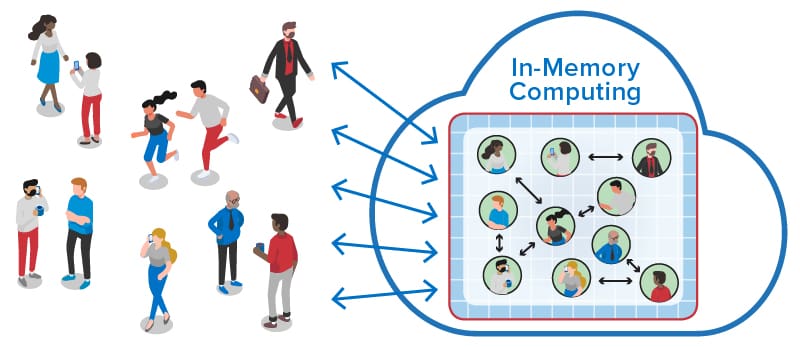
Note: To the extent possible, ScaleOut Software will make its cloud-based ScaleOut Digital Twin Streaming Service available free of charge (except for fees from the cloud provider) for public institutions needing help tracking data to assist in the COVID19 crisis.
available free of charge (except for fees from the cloud provider) for public institutions needing help tracking data to assist in the COVID19 crisis.
Summing Up
Anonymous, voluntary, contact self-tracing has the potential to fill an important gap as a hybrid approach between manual contact tracing and complex, fully automated, location-based technologies. In work settings, it could be especially useful in protecting colleagues and customers. It offers a powerful tool to help contain the spread of COVID19, maximize situational awareness for healthcare workers and contact tracers, and minimize risks from exposure for all of us.
The post Voluntary & Anonymous Contact “Self”-Tracing at Scale appeared first on ScaleOut Software.
]]>